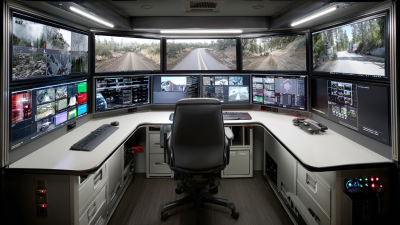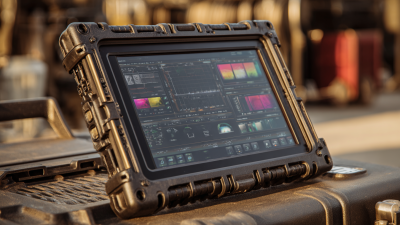Exploring the Future of Rugged Panel Computers: 2023 Trends and Industry Insights
The rugged panel computer market is poised for significant advancements in 2023, driven by the increasing demand for robust and reliable computing solutions across various industries, including manufacturing, logistics, and military applications. According to a recent industry report by MarketsandMarkets, the rugged computing market is expected to grow from $4.5 billion in 2022 to $6.2 billion by 2027, reflecting a compound annual growth rate (CAGR) of 6.5%. This growth is primarily fueled by the rising need for durable gear that can withstand harsh environments while providing seamless connectivity and performance.

As we explore the future trends and insights related to rugged panel computers, it is essential to consider their crucial role in enhancing operational efficiency and productivity in challenging conditions. The integration of advanced technologies, such as edge computing and IoT, is set to transform traditional rugged computing paradigms. Research from VDC Research predicts that the adoption of rugged panel computers with enhanced features will increase, as businesses recognize the value of deploying devices that blend performance and durability. In this report, we will delve into the top five trends shaping the rugged panel computer market in 2023, highlighting the innovations and market shifts that industry stakeholders should be aware of to stay competitive.
Key Features to Look for in Rugged Panel Computers for Industrial Use
When considering rugged panel computers for industrial use, there are several key features that stand out. First and foremost, durability is essential; these devices should be able to withstand extreme conditions, including temperature fluctuations, humidity, and physical shocks. Look for options that boast military-grade certifications such as MIL-STD-810, indicating their resilience in harsh environments. Additionally, a high ingress protection (IP) rating ensures that the computer is resistant to dust and water, further enhancing its suitability for industrial applications.
Another important feature is display quality. Rugged panel computers often operate in bright lighting conditions, so options with sunlight-readable screens are crucial. Anti-glare coatings and higher brightness levels enhance visibility, allowing operators to work effectively regardless of their surroundings. Furthermore, consider the interface options; touchscreens that work with gloves or styluses are particularly beneficial in industrial settings, where safety gear is mandatory. Lastly, robust connectivity options such as Wi-Fi, Bluetooth, and cellular capabilities ensure consistent communication and data transfer in dynamic environments, making them integral in modern industrial operations.
Emerging Technologies Shaping the Rugged Panel Computer Market in 2023
In 2023, the rugged panel computer market is experiencing remarkable advancements, underscored by the emergence of several transformative technologies. According to a recent report by MarketsandMarkets, the global rugged computing market is projected to reach USD 19.49 billion by 2027, growing at a CAGR of 8.9%. This growth is primarily driven by the increasing demand for reliable computing solutions in critical environments such as manufacturing, military, and healthcare. Enhanced durability and functionality are becoming central themes as manufacturers innovate to meet the rigorous demands of these industries.
One key trend shaping the market is the integration of IoT capabilities within rugged panel computers. This technology allows for real-time data monitoring and analytics, essential for sectors that rely heavily on operational efficiency. Additionally, advancements in display technology, such as non-glare touchscreens and enhanced brightness for outdoor visibility, are becoming standard features. Research by Frost & Sullivan highlights that the adoption of AI and machine learning in rugged systems is also on the rise, enabling predictive maintenance and reducing downtime in field operations. As these technologies develop, they are set to redefine the functionality and application of rugged panel computers across various sectors.
Best Practices for Selecting the Right Rugged Panel Computer for Your Operations
When selecting the right rugged panel computer for your operations, it’s crucial to assess the operational environment. Rugged panel computers are designed to withstand harsh conditions, including extreme temperatures, humidity, and vibrations. Evaluating the specific requirements of your work environment—such as exposure to dust, water, or chemicals—will help in choosing a model that can endure these conditions without compromising performance.
Another vital consideration is the technology and features of the panel computer. Look for systems that offer high-resolution displays, touch capability, and robust processing power to handle your applications seamlessly. Performance benchmarks and reliability ratings from industry leaders can provide valuable insights into durability and efficiency. Moreover, ensure that the computer supports robust connectivity options, as seamless communication is essential in many operations. By prioritizing these criteria, organizations can enhance productivity and ensure operational continuity in challenging settings.
Future Challenges and Opportunities in the Rugged Computing Sector
The rugged computing sector is at a pivotal point in 2023, facing both challenges and opportunities that shape its future trajectory. One significant challenge is the increasing demand for high-performance computing in extreme environments. As industries such as construction, manufacturing, and military operations push the limits of technology, manufacturers are compelled to innovate continuously. Incorporating advanced materials and battery life optimization will be crucial for meeting the evolving needs of end-users who require reliable devices that can withstand harsh conditions while delivering superior performance.
On the other hand, the rise of the Internet of Things (IoT) presents a unique opportunity for rugged panel computers. Integrating IoT capabilities can enhance data connectivity and analytics in real-time, thus improving efficiencies in various operations. As industries embrace smart technologies, rugged computing solutions can become integral to data collection and management systems, setting standards for operational resilience. Ultimately, the intersection of rugged computing with advancements in IoT and AI can drive growth, allowing manufacturers to carve out new market niches while addressing the increasing complexities in industrial environments.
Exploring the Future of Rugged Panel Computers: 2023 Trends and Industry Insights
| Trend/Insight | Description | Impact on Industry | Opportunities | Challenges |
|---|---|---|---|---|
| Increased Demand | Growing need for rugged devices in harsh environments. | Boost in sales and innovation. | Development of niche products. | Supply chain disruptions. |
| Technological Advancements | Integration of AI and IoT in rugged devices. | Enhanced functionality and efficiency. | New market segments. | Rapid tech evolution may lead to obsolescence. |
| Customization | Increasing demand for tailored solutions. | Satisfaction of diverse customer needs. | Unique selling propositions. | Complexity in manufacturing processes. |
| Sustainability | Focus on environmentally friendly materials. | Positive brand image and compliance. | Appeal to eco-conscious consumers. | Higher production costs. |
| Remote Work Adaptation | Rise in remote working environments for various industries. | Broader usage scenarios for rugged devices. | Expansion into new business sectors. | Need for robust cybersecurity measures. |
Impact of Environmental Conditions on Rugged Panel Computer Performance
Rugged panel computers are increasingly essential in diverse industries, especially where environmental conditions can significantly impact performance. According to recent testing, the best rugged devices of 2025 have been specifically engineered to endure extreme temperatures, high humidity, and challenging terrains. For instance, rugged tablets undergo rigorous testing to ensure they can withstand drops, vibrations, and exposure to dust and water, making them reliable tools for outdoor and industrial applications.
Moreover, advancements in technology have led to an increased demand for devices that not only meet military-grade standards but also excel in battery performance and user interface in hostile environments. Reports indicate that professionals rely on rugged computers which have been evaluated for operational efficiency in adverse conditions, showcasing their durability in real-world scenarios. As rugged computing continues to evolve, it becomes apparent that understanding the impact of environmental conditions on performance is crucial for selecting the right equipment for demanding tasks.
Exploring the Future of Rugged Panel Computers: 2023 Trends
This chart illustrates the performance impact of various environmental conditions on rugged panel computers in 2023. The data highlights how temperature, humidity, and vibration affect the operational capability of these devices.
Related Posts
-

Exploring the Future: Top 5 Use Cases for Rugged Panel Computers in Extreme Environments
-

Ultimate Guide to Choosing the Right Rugged Panel PC for Your Business Needs
-

The Comprehensive Ultimate Guide to Choosing the Right Rugged Panel Computer for Your Needs
-

Mastering the Industrial Panel PC Revolution for Optimal Manufacturing Efficiency
-

5 Features That Make Rugged Panel Computers the Best Choice for Tough Environments
-

How to Choose the Right Rugged Panel Computer for Your Toughest Environments

